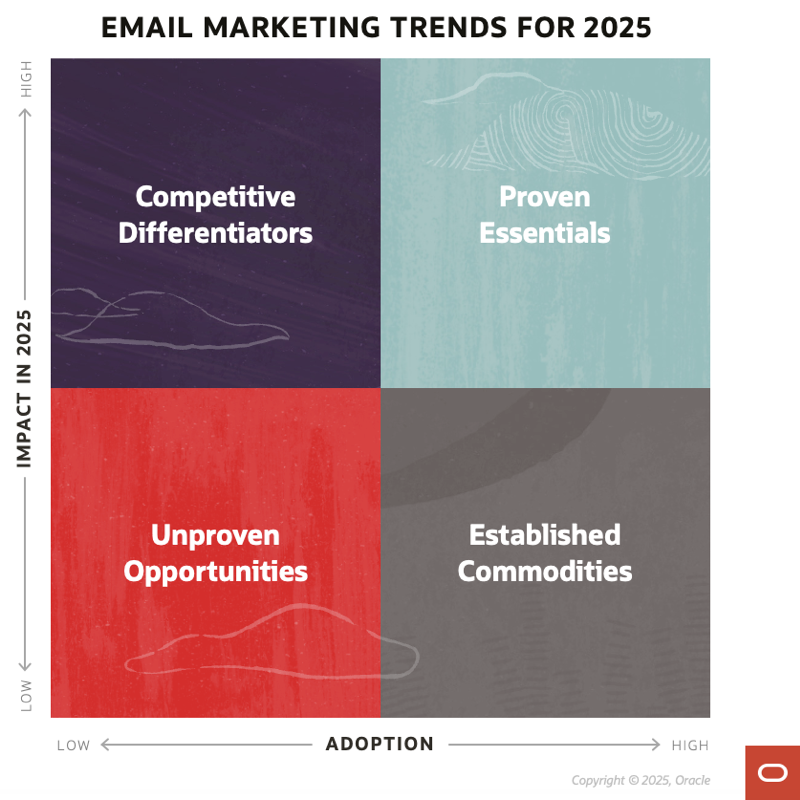Email marketing is constantly evolving, so it can be difficult to know where to invest your time and energy from year to year. Just a few of the recent changes and challenges that email marketers have faced include:
- Economic uncertainty caused by global trade disruptions, high inflation, and high interest rates
- Changes at inbox providers, including broader BIMI support, Apple’s launch of iOS 18, and Gmail’s increasing use of Automatic Extraction
- Generative AI raising concerns and opportunities across the marketing spectrum
To help you prioritize your email marketing efforts this year, we surveyed Oracle Digital Experience Agency’s hundreds of digital marketing experts for the sixth year in a row, asking them to rate the current adoption of a range of email marketing technologies and tactics, as well as the impact they predict each will have in 2025. Then we mapped the results into adoption-impact quadrants.

However, in this post, we’re going beyond the quadrant placements to look at the highest impact trends overall, the trends with the biggest increases and decreases in adoption and impact, the trends with the largest gap between its impact and its adoption, and more.
The Highest Impact Trends Overall
The most impactful trends are in our Competitive Differentiator and Proven Essentials quadrants. But to focus on the highest impact trends, we’ll only highlight the trends in the upper half of those two quadrants.
Unlike last year when only four trends cleared that bar, this year it’s six:
- Omnichannel orchestration
- Advanced performance analytics
- Loyalty programs
- Email personalization
- Email segmentation
- Automation or triggered emails
Those last three trends—personalization, segmentation, and automation—have made our highest impact trends list in all six years of our survey. And rightfully so. Those three trends are the three legs of the stool when creating a relevant email marketing program.
The Biggest Increase in Adoption
Adoption of generative AI for email personalization jumped by 21%, according to our digital marketing experts. That said, we think much of that “adoption” is actually early experimentation on the road to eventual program rollouts. Especially among enterprises, brands have been very cautious in letting generative AI communicate directly with customers without human oversight. However, the interest in genAI for personalization is absolutely a big growth area.
The Biggest Increase in Impact
Our experts see Brand Indicators for Message Identification (BIMI) as being 6% more impactful this year than last. The jump is understandable given Apple’s broader support of BIMI via their Branded Mail in Apple Business Connect, as well as Google’s decision to accept easier-to-obtain Common Mark Certificates (CMCs) in addition to Verified Mark Certificates (VMCs).
Because of these changes, we estimate that the average brand could see 90% or more of their emails displayed with their logo next to their sender name. That’s a powerful branding and trust-building opportunity.
Related post: BIMI Email Standard Gets Big Boost by Becoming Less of a Standard
The Biggest Decrease in Adoption
Universal holdout groups are seen by our experts as suffering the biggest decline in adoption, falling 7%. These programs withhold email campaigns from a small percentage of subscribers to then measure the impact of these campaigns by comparing the behavior of the holdout group to the other subscribers.
It’s a pure way of measuring campaign lift, but it comes with an opportunity cost, since you’re missing out on the impact of campaigns on the holdout group. Managing holdout groups can also be rather involved. Because of those challenges, holdout group usage tends to be volatile from year to year.
Related post: Universal Control Groups: The Path to Digital Marketing Measurement Clarity
The Biggest Decrease in Impact
Surveyed after the election, our experts see legal compliance as being 6% less important this year. With Republicans gaining control of the House, Senate, and presidency, the passage of the American Privacy Rights Act seems highly unlikely. Also unlikely is the passage of permission-based digital marketing rules to replace the antiquated CAN-SPAM Act and better align the US with the modern marketing laws of other first-world nations, such as GDPR.
Related post: Pressure Builds for New US Privacy Law as State Laws Pile Up
Largest Gap between Adoption and Impact
Big disconnects between current adoption and the anticipated impact of a trend can signal big competitive opportunities for brands. This year, our experts think the biggest opportunity is with using generative AI to help copywriters create email content. They see the impact of this trend being 157% higher than its current adoption, which is low.
While our experts are excited by the opportunity this technology presents to accelerate email content creation, they also acknowledge risks, including:
- Protecting marketing plans and content
- Controlling for content accuracy
- Maintaining brand voice
- Doing change management in a responsible way
Many of our clients are easing into generative AI. They’re doing small-scale or localized experiments, such as with subject lines, and founding working groups to explore and manage their use of genAI. So, full-scale rollouts are not the norm among enterprises by a long shot.
Related webinar: AI Opportunities Throughout the Email Production Process [with on-demand webinar]
For a Deeper Dive
We discuss all of those trends and much, much more in this 56-minute on-demand webinar. Watch it now to gain a clearer understanding of the major shifts in email marketing priorities so you can effectively plan your own email investments and strategies for 2025.
For a full look at the email marketing trends to watch for in 2025, also check out our posts that examine:
- Unproven Opportunities, which are low-impact trends with low adoption
- Competitive Differentiators, which are high-impact trends with low adoption
- Proven Essentials, which are high-impact trends with high adoption (coming soon)
Also, for a better understanding of how all of these email marketing trends are evolving, check out our email marketing trends posts from last year:
- Email Marketing Trends for 2024: Unproven Opportunities
- Email Marketing Trends for 2024: Competitive Differentiators
- Email Marketing Trends for 2024: Proven Essentials
- The Biggest Shifts in Email Marketing Trends for 2024
—————
Need help with your customer experience and digital marketing campaigns? Oracle Digital Experience Agency has hundreds of marketing and communication experts ready to help Responsys, Eloqua, Unity, and other Oracle customers create stronger connections with their customers and employees—even if they’re not using an Oracle platform as the foundation of that experience. With a 94% satisfaction rate, our clients are thrilled with the award-winning work our creative, strategy, and other specialists do for them, giving us an outstanding NPS of 82.
For help overcoming your challenges or seizing your opportunities, talk to your Oracle account manager, visit us online, or email us at OracleAgency_US@Oracle.com.
To stay up to date on customer experience best practices and news, subscribe to Oracle Digital Experience Agency’s award-winning, twice-monthly newsletter. View archive and subscribe →



